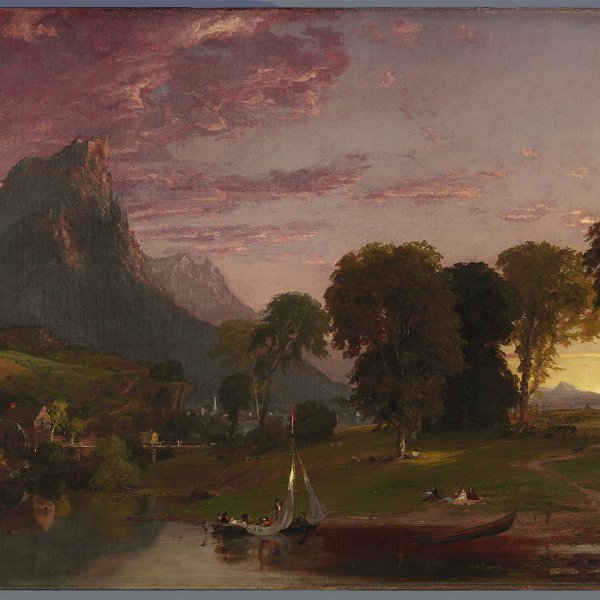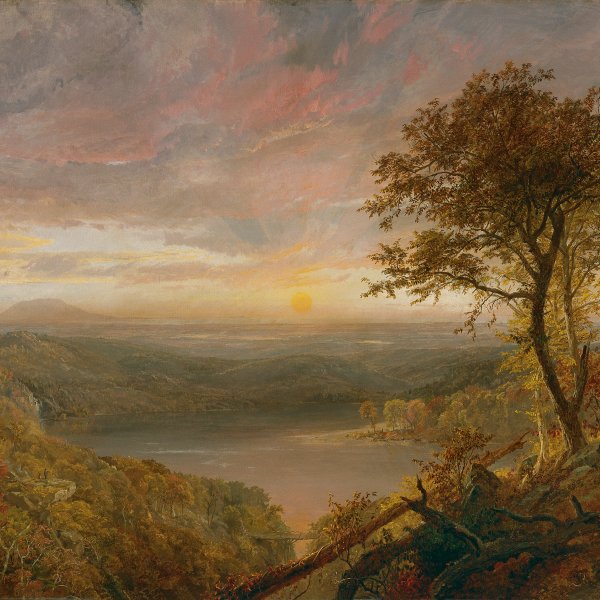Jasper Francis Cropsey
Rossville, 1823-Hastings-on-Hudson, 1900
Jasper F. Cropsey was one of the foremost landscape artists of the American Hudson River School, although he trained as an architect and practiced intermittently throughout his lifetime. He began to show his work at the National Academy of Design in New York, of which he was elected a member in 1844, on account of the success of the landscapes he painted following his first visit to Greenwood Lake that year. There he found the idyllic nature he yearned to depict, which thenceforth became the main subject of his paintings.
After marrying Maria Cooley, he departed for Europe and made the compulsory Grand Tour from 1847 to 1849. In Rome he settled into the same studio that had been occupied by Thomas Cole, an artist who influenced him at the outset of his career. On returning in 1849, he opened a studio in New York and travelled to different places during the summer. From 1857 to 1863 he lived and worked in London, where his landscapes enjoyed huge popularity as they had in America. In the English capital Cropsey completed the most ambitious landscape of his entire career, Autumn on the Hudson (Washington, National Gallery of Art), in 1860. This canvas, which was shown at the London International Exhibition of 1862, established him as “America’s painter of autumn.” Cropsey’s style of painting combined road, sweeping panoramic views characteristic of the Hudson River School with a study of light and tonal gradations that was reminiscent of Luminism.
On returning to America, Cropsey had a grand house built by Greenwood Lake. It was located near Warwick and built in the style of Victorian mansions. The artist christened it with the exotic name of Aladdin. At the end of his career his work lost prestige as his painstaking, realistic style and somewhat theatrical compositions were gradually ousted from favour by the smaller paintings executed by younger painters under the influence of the Barbizon School. The financial problems derived from this situation forced him to sell Aladdin and move to Hastings-on-Hudson, where he set up a new studio that now houses the Newington-Cropsey Foundation.
After marrying Maria Cooley, he departed for Europe and made the compulsory Grand Tour from 1847 to 1849. In Rome he settled into the same studio that had been occupied by Thomas Cole, an artist who influenced him at the outset of his career. On returning in 1849, he opened a studio in New York and travelled to different places during the summer. From 1857 to 1863 he lived and worked in London, where his landscapes enjoyed huge popularity as they had in America. In the English capital Cropsey completed the most ambitious landscape of his entire career, Autumn on the Hudson (Washington, National Gallery of Art), in 1860. This canvas, which was shown at the London International Exhibition of 1862, established him as “America’s painter of autumn.” Cropsey’s style of painting combined road, sweeping panoramic views characteristic of the Hudson River School with a study of light and tonal gradations that was reminiscent of Luminism.
On returning to America, Cropsey had a grand house built by Greenwood Lake. It was located near Warwick and built in the style of Victorian mansions. The artist christened it with the exotic name of Aladdin. At the end of his career his work lost prestige as his painstaking, realistic style and somewhat theatrical compositions were gradually ousted from favour by the smaller paintings executed by younger painters under the influence of the Barbizon School. The financial problems derived from this situation forced him to sell Aladdin and move to Hastings-on-Hudson, where he set up a new studio that now houses the Newington-Cropsey Foundation.




